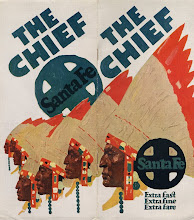Tuesday, December 22, 2009
Friday, December 18, 2009
DONATION OF RARE HUGO GELLERT PORTFOLIO TO THE WOLFSONIAN LIBRARY
We are delighted to be able to recognize the donation of an extraordinarily rare oversized portfolio to the Wolfsonian library collection by Elinor Brecher of Miami, Florida. Entitled, Century of the Common Man: two speeches by Henry A. Wallace, this portfolio contains double-page plates with excerpts of Vice President Henry Wallace’s speech and full-page silk-screened illustrations on the facing pages drawn by artist/activist Hugo Gellert (American, born in Hungary, 1892-1985). The portfolio was published in a limited edition of fifty-four, numbered and autographed by the artist. Hugo Gellert was an unabashedly outspoken member of the Communist Party of the United States of America and he lent all of his artist talents to championing that political cause.
This particular portfolio was published during the brief period of cordial U.S.-Soviet relations following the German invasion of Russia during the Second World War. After the invasion, Stalin deemed it expedient to seek the support of any and all left-leaning, liberal and "Popular Front" groups arrayed against the fascists. This latest donation joins two other oversized portfolios illustrated with lithographs by Gellert: Karl Marx Capital in Pictures and Comrade Gulliver: an Illustrated Account of Travel into that Strange Country the United States of America. These poster-sized portfolios comprise three of some thirty-four Gellert titles in our library. Several of his works were exhibited in a display organized by two Florida International University students last fall, and can be seen on line in a virtual display of their exhibition presently on view on the second floor of the Green Library on the Modesto Maidique Campus or accessible at the following web address:
http://www.librarydisplays.wolfsonian.org/Great%20Depression/GD%20displays.htm
Our thanks go out to Elinor Brecher for her generosity in donating this wonderful portfolio. As a repository with a wide range of Gellert materials in our collection, we hope to be able to organize an exhibition sometime in the future that will make these materials presently available to visiting scholars in our library, accessible to the general public visiting our galleries as well.
Wednesday, December 16, 2009
HAPPY HOLIDAYS FROM THE WOLFSONIAN-FIU LIBRARY
LIBRARY OBJECT(S) OF THE WEEK
Friday, December 11, 2009
RECEPTION FOR FIU STUDENT-CURATED EXHIBIT IN GREEN LIBRARY
At the close of the reception, the student curators were presented with tee shirts from the museum gift shop and copies of the poster for the exhibit created by the Wolfsonian’s own art director, Tim Hossler.
My special thanks to Laura Probst and Vicki Silvera for their support in providing the display space for this exhibition and for putting this reception together and providing refreshments. We look forward to working together with Vicki in planning some new collaborative exhibition projects.
Thursday, December 10, 2009
COLLECTIONS CARE AND PREVENTIVE CONSERVATION ASSESSMENT
Although the library does not presently have the trained staff or resources to undertake aggressive conservation treatments of some of the fragile and brittle works in the collection, we have been actively moving forward with a collection stabilization program. Given our location in the subtropics, donations and new acquisitions are screened for evidence of bookworm and silverfish activity. Suspect items are isolated and frozen in a special low-temp freezer at our off-site annex to prevent the possible transfer of insect infestations to the library. Library interns and volunteers have also been trained to create archival-quality, custom-fit Melinex sleeves for the delicate ephemera in the library collection using an ultrasonic polyester encapsulation machine put together on the premises by inventor William Minter a couple of years ago. This rather expensive machine—(partially funded by a generous Capital Development grant from Miami Dade County’s Department of Cultural Affairs)--has allowed us to produce inexpensive enclosures that provide brittle items with added tensile strength and protect them from the oils naturally found on our fingers. We have also recently ordered archival drop front storage boxes in order to re-house and better preserve the thousands of cruise ship industry promotional materials recently added to our collection by the donation of Dr. Laurence Miller.























